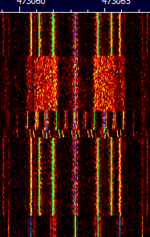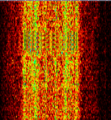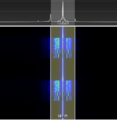AFSK Paging Link
| Paging Modes | |
|---|---|
| AFSKAudio Frequency-Shift Keying Paging Link - POCSAG - Glenayre Paging Link - FLEX - ReFLEX - Golay Paging (GSC) - European Radio Message System (ERMES) - Multitone Paging |
 | |
|---|---|
| Frequencies | 72 MHz,850 MHz,928 MHz,76 MHz,450 MHz,460 MHz,470 MHz |
| Frequency Range | 72 MHz - 928 MHz |
| Mode | NFM |
| Modulation | AFSK |
| ACF | — |
| Emission Designator | — |
| Bandwidth | 9 kHz |
| Location | Worldwide |
| Short Description | A variant of POCSAG/FLEX with audio FSK modulation based off of the bell 202 tones. Typically found as uplinks/downlinks to pager network transmitters. |
| I/Q Raw Recording | Download file |
| Audio Sample | |
|
POCSAG can be modulated with audio FSKFrequency-Shift Keying tones to ensure that audio modems can encode these properly. These variants use Bell 202 esque mark and spaces to modulate the signal.
The bandwidth of the original POCSAG signal determines how intense the modulation deviation is...
in the new england states: They use 1000 and 2300 hz. In the midwest, the bell 202 and a variant known as "1300-2100" also exist. 1300-2100 is for extremely low bandwidth pocsag... Phase inversion can also take place in some modulations which give off a slight difference in sound...
Contents
Audio files:[edit]
I/Q:[edit]
https://drive.google.com/open?id=1weV6dasw3XuFUqomQhKPgW242Hk4Ma5q
Images:[edit]
other examples:[edit]
Some other examples done with the dutch POCSAG encoder part of SoRFMon's suite of demo software, and modulated with various audacity plugins to create realistic waveforms:
The result when AFSKAudio Frequency-Shift Keying is mixed in with Flex @6400 BaudBaud (unit symbol Bd) is the unit for symbol rate or modulation rate in symbols per second.:








